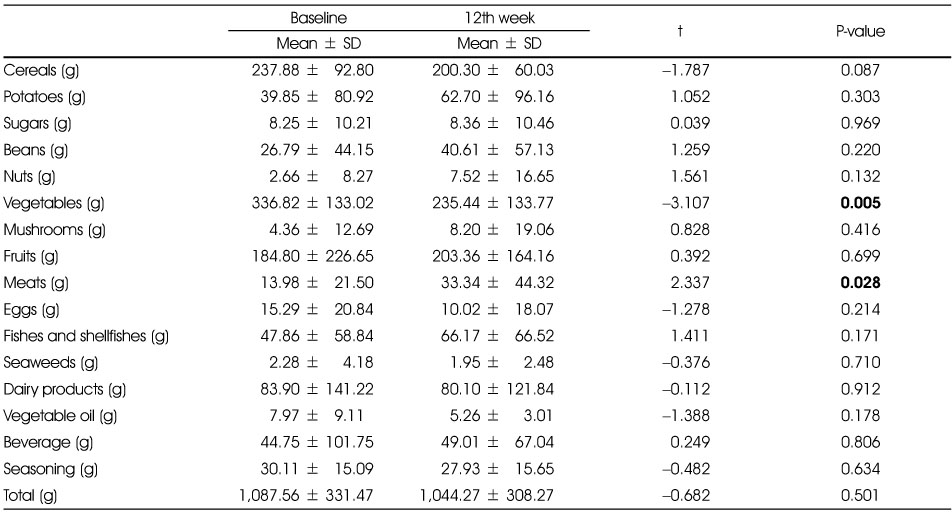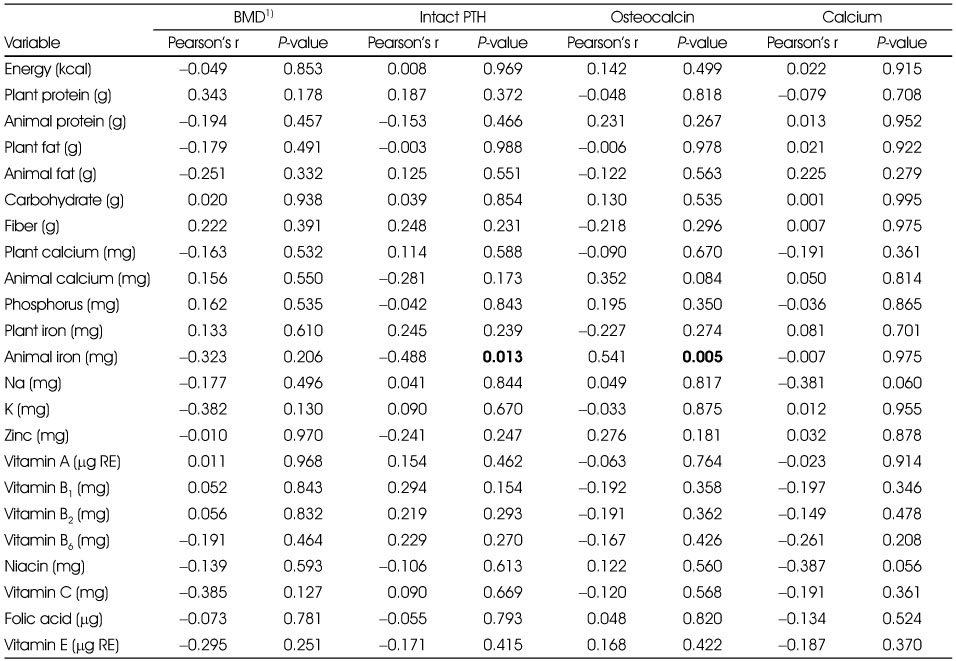Articles
- Page Path
- HOME > Korean J Community Nutr > Volume 18(3); 2013 > Article
-
Original Article
- The Association between Changes in Food and Nutrient Intakes and Changes in Bone Metabolic Indicators in Postmenopausal Women with Osteopenia after a 12-week Intervention of Nutrition Education and Aerobic Exercise
- Seo-Jin Kim, Suh-Jung Kang, Yoon Jung Park, Ji-Yun Hwang
-
Korean Journal of Community Nutrition 2013;18(3):213-222.
DOI: https://doi.org/10.5720/kjcn.2013.18.3.213
Published online: June 30, 2013
Department of Foodservice Management and Nutrition, Sangmyung University, Seoul, Korea.
1Department of Sports Science, Sangmyung University, Seoul, Korea.
2Department of Nutrition Science and Food Management, Ewha Womans University, Seoul, Korea.
3Nutrition Education Major, Graduate School of Education, Sangmyung University, Seoul, Korea.
- Corresponding author: Ji-Yun Hwang, Nutrition Education Major, Graduate School of Education, Sangmyung University, 7 Hongji-dong, Jongno-gu, Seoul 110-743, Korea. Tel: (02) 781-7521, Fax: (02) 2287-0104, jiyunhk@smu.ac.kr
Copyright © 2013 The Korean Society of Community Nutrition
This is an Open-Access article distributed under the terms of the Creative Commons Attribution Non-Commercial License (http://creativecommons.org/licenses/by-nc/3.0/) which permits unrestricted non-commercial use, distribution, and reproduction in any medium, provided the original work is properly cited.
- 782 Views
- 1 Download
- 1 Crossref
Figure & Data
REFERENCES
Citations

- A Comparison of Salty Taste Assessment, Dietary Attitude and Dietary Behavior among Adult and Senior Women by Region and by Age in Korea
Lin Jiang, Yun-Young Jung, Hyung-Sook Kim, Gi-Seon Nam, Jin-Sook Yun, Jong-Wook Kim, Yeon-Kyung Lee
Korean Journal of Community Nutrition.2015; 20(2): 109. CrossRef
Nutrition education program for bone health
Age and anthropometrics, indicators related to bone mineral density (BMD), and dietary behaviors related to bone health from baseline to follow-up in subjects with osteopenia (n = 25)
1) Dietary quality was assessed by Mini Dietary Assessment (Oh et al. 2007)
Food group intake from baseline to follow-up in subjects with osteopenia (n = 25)
Nutrient intake from baseline to follow-up in subjects with osteopenia (n = 25)
1) The proportion of subject whose intake was less than the Korean estimated energy requirements for females in her age (Korean Nutrition Society 2010).
2) The proportion of subject whose intake of both animal and plant sources was less than the Korean estimated average requirements for females in her age (Korean Nutrition Society 2010).
3) The proportion of subject whose intake was less than the Korean estimated average requirements for females in her age (Korean Nutrition Society 2010).
1),2),3) Statistical tests to examine differences in frequencies before and after intervention were not conducted (expected frequencies < 5)
Correlation between food group intakes change and change of indicators related to bone mineral density(BMD) (n = 25)
1) Data were available for 21 subjects.
Correlation between nutrient intakes change and change of indicators related to bone mineral density(BMD)
1) Data were available for 21 subjects.
1) Dietary quality was assessed by Mini Dietary Assessment (
1) The proportion of subject whose intake was less than the Korean estimated energy requirements for females in her age (Korean Nutrition Society 2010). 2) The proportion of subject whose intake of both animal and plant sources was less than the Korean estimated average requirements for females in her age (Korean Nutrition Society 2010). 3) The proportion of subject whose intake was less than the Korean estimated average requirements for females in her age (Korean Nutrition Society 2010). 1),2),3) Statistical tests to examine differences in frequencies before and after intervention were not conducted (expected frequencies < 5)
1) Data were available for 21 subjects.
1) Data were available for 21 subjects.

 KSCN
KSCN






 PubReader
PubReader Cite
Cite


